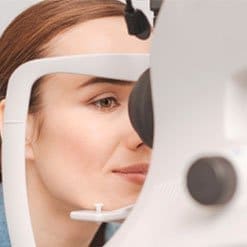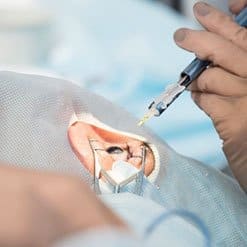Crosslinking (x-linking, CXL)
Table of Content
Cross -linking surgery is applied in keratoconus treatment and performed in early stage of disease
Anasthesia – local
Duration of surgery : about 1 h
Crosslinking. General information.
In this surgery, unique structural characteristics of cornea are taken advantage of . Ultraviolet irradiation produces collagen cross-linking (cross-linking) in the cornea, thereby it becomes stronger, stiffer and less deformable. This allows the suppression of the further development of keratoconus.
Keratoconus (keratoconus, Greek: kerato-cornea and Konos-cone) is a degenerative, non-inflammatory disease of the cornea of the eye, in the course of which a change in the structure of the cornea leading to thinning and excessive convex , the cornea takes the shape of a cone. This change greatly deteriorates vision. The incidence of this dystrophy is only 1 in 1,000 people.
Symptoms of keratoconus:
- rapidly progressive deterioration of visual acuity of rapidly progressive blurring, distortion of the image in one eye with rapidly growing astigmatism and myopia in one eye
- blurring of the image (poliopia monocular)
- over-sensitivity to light (photophobia)
- itching and redness
- symptom of a halo around the light source (blured sharpness of vision)
- rarely the first symptom is the so-called. sharp cone – a sudden hazy vision, which may persist for several weeks and cause eye pain
Vision of a healthy person ( on the left ) and vision simulation of a person with keratoconus (on the right)


Who gets qualified for surgery?
Surgery is perforned on patients with keratoconus of 1st and 2nd degree according to Amsler. – decision is taken by the doctor
Classification of karatoconus
Classification acc.to Amsler, extender with corneal cam by Dieter Muckenhirn.
| Degree | Amslera angle | Middle rays | Vision equity glasses |
Vision equity lens angle |
Transparency | Cornea
thickness |
Cam |
|---|---|---|---|---|---|---|---|
| 1 | 0-3 | >7.5 | 1.0-0.8 | >1 | Normalna | 0.5 | <0.8 |
| 2 | 4-9 | 7.5-6.5 | 0.8-0.2 | 1.0-0.8 | Normalna | 0.4 | 0.8-1.0 |
| 3 | > 9 | 6.5-5.8 | 0.2-0.1 | 0.4-0.8 | Lekko zmętniała | 0.25 | 1.2-1.5 |
| 4 | Nie można zmierzyć | <5.8 | <0.1 | 0.2-0.4 | Silnie zmętniała | <0.2 | >1.5 |
Course of crosslinking
The first stage in the treatment is anesthesia of cornea with drops. Then antibiotics are given to protect the operated eye against possible infections. Using special surgical instruments, cells of the cornea surface are removed . The next stage is instillation of the operated eye by eye drops containing riboflavin (vitamin B2) for a few minutes. When it is determined that an adequate amount of riboflavin was absorbed by the cornea, the eye is irradiated by UVX laser . This process takes about 30 minutes. Earlier applied riboflavin enforces absorption of UVA light through the cornea. UVA light is the so- called. UV long wave, characterized by a wave length of 400 nm-315 nm. After the surgery the eye dropped again with antibiotics and lens protection is placed . It is recommended to wear it for 1-2 days after surgery.
How long after surgery will the effects be visible?
UVA light, which has been absorbed by the cornea causes creation of the so-called. cross-links (cross linking) and thus can increase cornea networking – increasing the number of bonds which strengthen the cornea. The increase in the number of bonds takes place within a few days after surgery. It should be noted that cross-linking does not flatten keratoconus, but only inhibits its growth.
What are the post-surgery recommendations?
After taking off lens protection, it is recommended to use eye drops for several weeks.
Is it possible to wear contact lenses after surgery?
After about one month after surgery and consultation with physician, contact lenses may be worn without any fears.
Is UV light, which used during surgery, harmful?
UVA light in this procedure is strictly regulated and controlled – it is completely harmless. Light emitter (laser UVX) is provided with a special locking system, so that even during failure , the patient remains safe. Moreover, the use of riboflavin (vitamin B2) protects structures of the eye against UVA, which only penetrates the cornea. However, no known long-term risk (20 years or more after operation ) due to the surgery, but based on the experience of our team and other institutions in the world, it can be stated that it is a relatively safe procedure.
May crosslinking surgery fail?
As it may happen during any surgery, the desired effect cannot be achieved. However, it is only after 6 to 8 months post- surgery that results are possible to be evaluated.
Complications:
- swelling of the cornea – usually transient
- haziness
- turbidity
- scarring
- corneal endothelial cell damage
Most of these complications are said to be only hypothetical as they appear only very seldom.






